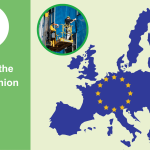The Energy Charter Treaty is controversial and an obstacle for the clean energy transition. Questioning its legality under EU law is getting stronger.
Beyond its detrimental impact on climate action, the question of whether EU law even allows the Energy Charter Treaty (ECT) to be used in disputes between Member States has also been raised. An Advocate General of the Court of Justice of the European Union (CJEU), Maciej Szpunar, addressed this question in an opinion published on 3 March in the ongoing case regarding the validity of an ECT arbitration between Moldova and a Ukrainian investor.
The ECT is an international investment treaty that protects investments in the energy sector. It allows investors to challenge state measures in a private arbitration mechanism called investor-state dispute settlement (ISDS) and to claim millions in compensation. The treaty has increasingly come under fire for its potential to hinder climate policies.
Can an EU investor sue an EU Member State?
The question of whether the ECT can be used in disputes involving an EU investor and another Member State (so-called “intra-EU” disputes) has been much-debated since the CJEU’s decision in the Achmea case in 2018. In this case, the Court decided that ISDS provisions in bilateral investment treaties (BITs) between Member States are illegal under EU law. The Court did not state whether this meant that all ISDS between Member States was illegal, which led to diverging interpretations among the Member States on what this meant for the legality of intra-EU ISDS cases under the ECT.
In his opinion on March 3, the Advocate General shed some light on this question by arguing that ISDS in intra-EU disputes is indeed not allowed under EU law. This is because the arbitral tribunal resolving the dispute would likely have to interpret EU law without being part of the EU legal order, in which the Court of Justice of the European Union has the final say in cases of diverging interpretations of the law. Further, the Advocate General noted that the very idea of bringing disputes before a private arbitration panel rather than national courts was against the principle of mutual trust, i.e. that the Member States have confidence in each others’ national courts.
What next?
The Advocate General’s opinion is not binding on the Court, which is expected to give a final ruling on the case this summer. However, the Court generally tends to follow the conclusions of the Advocates General. Were the Court to rule that the use of ISDS is not allowed between Member States, the Member States would be forced to end the applicability of the ECT amongst each other. The Member States could do this by concluding an agreement amongst themselves to rule out such intra-EU disputes.
This would be a step in the right direction to make the ECT less dangerous for climate action. For instance, intra-EU claims such as the one made by German RWE against the Netherlands would no longer be allowed. Since the majority of cases brought under the treaty so far have taken place between an EU investor and another Member State, this would likely have a significant impact on the number of new cases.
However, it would not solve all the issues because for instance claims of UK and Swiss investors against EU Member States or the EU itself – such as Rockhopper v. Italy and Nord Stream 2 v. EU – would continue, so even if the EU finds a way to exclude the possibility of intra-EU claims, the ECT would continue to allow fossil fuel investors from non-EU states – including shell companies – to challenge climate action. This is why the EU and its Member States should withdraw from the treaty to also prevent such challenges from non-EU investors.
Unanswered questions remain
Unfortunately, the story doesn’t end here. Arbitration panels might refuse to accept that they are not meant to rule in intra-EU disputes. In the past, they have ignored the Achmea ruling by the CJEU and there are a range of cases in which EU Member States are disputing the right of arbitration panels to rule in cases brought by EU investors.
Such cases then go to national courts and some of them have requested the CJEU to clarify the status of the ECT under EU law. For instance, a Swedish court also sought a preliminary ruling on the issue in February 2021, asking the CJEU to determine whether EU law allows the use of ISDS in ECT disputes amongst member states. In December 2020, Belgium asked the Court whether the ISDS provision in the ECT complies with EU law.
The question that no one has asked yet
So, a number of questions concerning the compatibility between the ECT and EU law have already been referred to the CJEU and we should hear the Court’s opinion soon. However, there is yet another question concerning the legality of EU law that no one has asked the Court to clarify yet, namely whether the ISDS mechanism contained in the ECT is legal for disputes brought by non-EU investors against an EU Member State.
The CJEU has set certain minimum requirements for international treaties providing for investment arbitration in its Opinion 1/17 on the EU-Canada agreement CETA. It ruled that the arbitration system must 1) guarantee the impartiality of judges; 2) provide for an appeal mechanism; 3) guarantee that arbitration panels only interpret the agreement itself, not EU or national law. The ISDS mechanism in the ECT doesn’t fulfil any of these requirements, nor will modernisation address this because a reform of the ISDS mechanism is not even on the agenda.
The lack of compliance with these criteria means that the CJEU could reject even the modernised version of the ECT as incompatible with EU law, which would likely hinder its eventual ratification.



